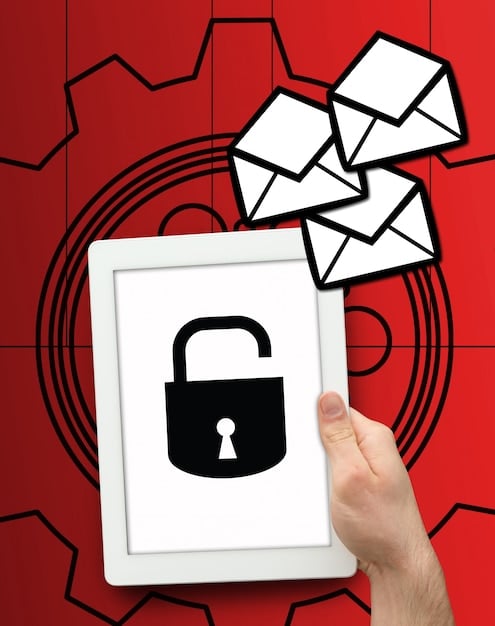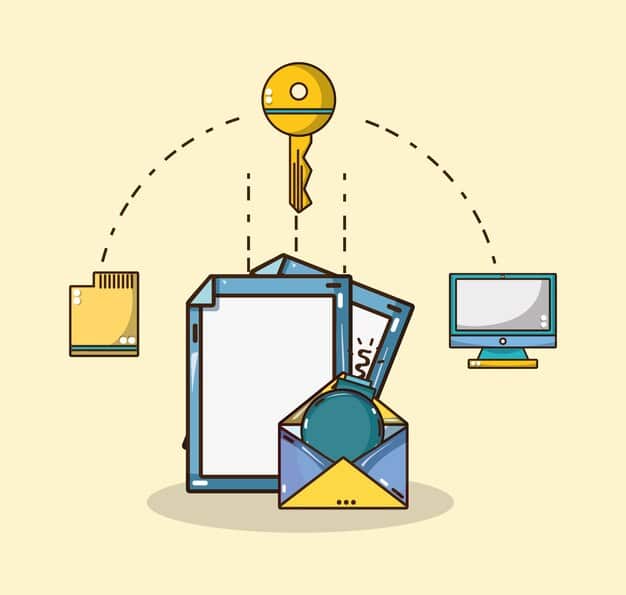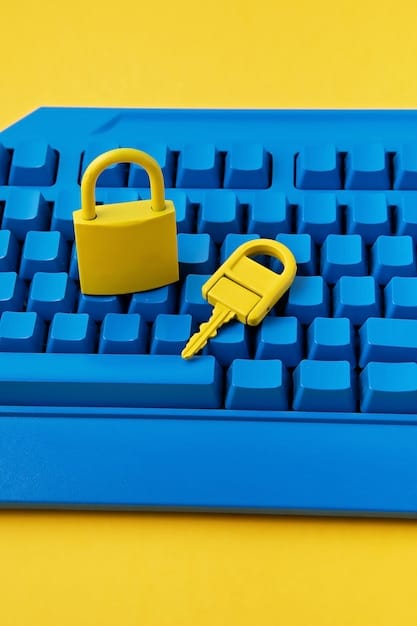Secure Your Email: A Step-by-Step Guide to PGP Encryption in 2025

Securing your email using Pretty Good Privacy (PGP) encryption is crucial in 2025 to protect sensitive information from unauthorized access, ensuring privacy and maintaining confidentiality in digital communications.
In 2025, ensuring the privacy of your digital communication is paramount. One of the most effective methods to achieve this is through email encryption. This guide offers a step-by-step guide to using PGP encryption in 2025, empowering you to safeguard your sensitive information.
Understanding the Importance of Email Encryption in 2025
As we navigate the digital landscape of 2025, the importance of email encryption cannot be overstated. With the increasing sophistication of cyber threats and breaches, securing your email communications is no longer optional but a necessity. Let’s delve into why email encryption is vital for your online privacy and security.
Why Email Encryption Matters
Email encryption transforms readable text into an unreadable format, protecting it from prying eyes. It ensures that only the intended recipient can decrypt and read the message. Without encryption, your emails are vulnerable to interception and unauthorized access.
Data breaches and cyberattacks are becoming more frequent and sophisticated. If your emails are not encrypted, they can be easily intercepted by hackers, giving them access to sensitive personal and financial information. Email encryption provides a critical layer of security, keeping your communications private and secure.
Email encryption can help you comply with data privacy regulations like GDPR and CCPA. These laws require organizations to protect personal data, and email encryption is a key tool for meeting these requirements. By encrypting your emails, you demonstrate your commitment to protecting your customers’ privacy and avoiding costly penalties.

How PGP Encryption Works
PGP, or Pretty Good Privacy, is a widely used encryption program that provides cryptographic privacy and authentication for data communication. Let’s explore the underlying mechanisms.
- Public and Private Keys: PGP encryption uses a pair of keys: a public key and a private key. The public key is shared with others, while the private key is kept secret.
- Encryption Process: When someone sends you an encrypted email, they use your public key to encrypt the message. Once encrypted, only your private key can decrypt the message.
- Digital Signatures: PGP also allows you to digitally sign your emails, verifying your identity and ensuring that the message has not been tampered with.
In conclusion, email encryption, especially using PGP, is crucial for safeguarding your privacy and security in 2025. As cyber threats evolve, taking proactive steps to protect your email communications is essential.
Setting Up PGP Encryption: A Step-by-Step Guide
Setting up PGP encryption might seem daunting, but with the right tools and instructions, it can be a straightforward process. This section will guide you through the steps to set up PGP encryption on your devices in 2025.
Choosing the Right Software
Several software options are available for PGP encryption, each with its own advantages and disadvantages. Select the one that best fits your needs.
Gpg4win is a popular choice for Windows users. It is a free and open-source suite of tools that includes everything you need to encrypt and decrypt emails. Mac users can opt for GPG Suite, which provides similar functionality.
Enigmail is a Thunderbird extension that adds PGP encryption capabilities to the email client. It is easy to install and use, making it a great option for those who prefer Thunderbird. For those using Outlook, consider Microsoft S/MIME.
Generating Your Key Pair
Once you’ve chosen your PGP software, the next step is to generate your key pair – a public key and a private key. Here’s how to do it.
- Open Your PGP Software: Launch the software you’ve chosen (e.g., Gpg4win, GPG Suite, Enigmail).
- Generate a New Key Pair: Look for an option such as “Generate Key,” “New Key,” or “Create Key Pair.”
- Enter Your Information: You’ll be prompted to enter your name and email address. This information will be associated with your key.
- Set a Strong Passphrase: Choose a strong, unique passphrase to protect your private key. This passphrase should be different from your email password.
- Wait for Key Generation: The software will generate your key pair. This process may take a few minutes.

By following these steps, you can successfully set up PGP encryption on your devices and start securing your email communications in 2025. Choose the software that best fits your needs and follow the instructions carefully to generate your key pair.
Integrating PGP with Your Email Client
Integrating PGP with your email client is crucial for seamless encryption and decryption of emails. This process varies slightly depending on the email client you use, but the underlying principles remain the same. Let’s examine how to integrate PGP with popular email clients.
Integrating with Thunderbird using Enigmail
Enigmail is a popular extension for Thunderbird that makes PGP integration simple and efficient. To integrate PGP with Thunderbird using Enigmail, follow these steps:
- Install the Enigmail extension from the Thunderbird Add-ons store.
- Restart Thunderbird to activate Enigmail.
- Configure Enigmail by navigating to the Enigmail menu and selecting “Setup Wizard.”
- Follow the wizard to configure your PGP keys and settings.
Once configured, Enigmail will automatically detect PGP-encrypted emails and allow you to decrypt them using your private key.
Integrating with Outlook using Gpg4win
Integrating PGP with Outlook requires a bit more effort, but Gpg4win provides the necessary tools. Here’s how to do it:
- Install Gpg4win on your computer.
- Configure Gpg4win to work with Outlook by following the instructions provided during the installation process.
- Use the GpgOL plugin (included with Gpg4win) to encrypt and decrypt emails directly within Outlook.
GpgOL adds buttons to Outlook’s email composition window, allowing you to encrypt, sign, and decrypt emails with ease.
Best Practices for Secure Email Communication
In addition to integrating PGP with your email client, there are several best practices you should follow to ensure secure email communication.
- Always encrypt sensitive information. Whenever you’re sending an email that contains personal or confidential data, encrypt it using PGP.
- Verify the recipient’s public key. Before sending an encrypted email, verify that you have the correct public key for the recipient.
- Use strong passphrases. Protect your private key with a strong and unique passphrase.
- Regularly update your PGP software. Keep your PGP software up-to-date to protect against security vulnerabilities.
By integrating PGP with your email client and following these best practices, you can significantly enhance the security of your email communications in 2025. This integration ensures that your messages remain private and protected from unauthorized access.
Sharing Your Public Key Securely
Sharing your public key securely is a critical step in the PGP encryption process. Your public key allows others to send you encrypted emails, but it’s crucial to ensure that the key they have is authentic and has not been tampered with. This section outlines the best methods for sharing your public key securely.
Uploading to Key Servers
Key servers are repositories where you can upload and share your public key with others. These servers allow people to search for your key using your name or email address. Here’s how to use key servers effectively:
- Choose a reputable key server. Popular options include keys.openpgp.org and pgp.mit.edu.
- Upload your public key to the key server using your PGP software.
- Ensure your key is properly configured and associated with your email address.
By uploading your key to a key server, you make it easily accessible to others who want to send you encrypted emails.
Sharing Via Secure Channels
In addition to key servers, you can also share your public key directly with individuals using secure channels. This method provides an extra layer of verification.
Share your public key via encrypted messaging apps such as Signal or WhatsApp. These apps provide end-to-end encryption, ensuring that your key is transmitted securely. You can also use secure file-sharing services like Tresorit or ProtonDrive.
Include your public key in your email signature. This allows recipients to easily access your key when they receive an email from you. However, make sure to also share it via another method to provide additional verification.
Verifying Key Fingerprints
A key fingerprint is a unique identifier for your public key. Sharing your key fingerprint allows others to verify that the key they have is authentic.
- Share your key fingerprint on your website or social media profiles.
- Include your key fingerprint in your email signature.
- When someone receives your public key, they can use their PGP software to calculate the key fingerprint and compare it to the one you provided.
Securely sharing your public key is essential for establishing trust and ensuring that your encrypted communications remain private. By using a combination of key servers, secure channels, and key fingerprints, you can ensure that others have access to your authentic public key and can send you encrypted emails with confidence.
Troubleshooting Common PGP Issues
While PGP encryption is a powerful tool for securing email communications, users may encounter issues during setup and usage. Troubleshooting these common PGP issues can help ensure a smooth and secure experience. Let’s examine some typical problems and their solutions.
Key Generation Problems
Users may encounter issues when generating their key pair, such as software errors or incomplete key generation.
Ensure your PGP software is up to date. Outdated software may contain bugs that prevent proper key generation. Check your software’s documentation for specific troubleshooting steps. Key generation can take a long time, especially on older computers. Make sure to allocate sufficient time for the process to complete.
Consider alternative software as compatibility issues may arise with certain operating systems or hardware, preventing key generation. Trying a different program can sometimes resolve these issues.
Decryption Errors
Decryption errors occur when a user is unable to decrypt an encrypted email, which can be due to several reasons.
- Verify that you are using the correct private key. Decryption requires the private key associated with the public key that was used to encrypt the email.
- Ensure your PGP software is properly configured and integrated with your email client.
- Confirm that the sender used your correct public key when encrypting the email. If the sender used the wrong public key, you will not be able to decrypt the message.
Key Revocation
Revoking a key signifies that the key is no longer secure and should not be used for encryption. This might be necessary if your private key is compromised.
Use your PGP software to generate a revocation certificate. This certificate can be used to inform others that your key is no longer valid and should not be used. Upload the revocation certificate to key servers to ensure that others are aware that your key has been revoked. Inform your contacts directly that your key has been revoked, and provide them with your new public key, if applicable.
By addressing these common issues, users can maintain a secure and reliable email encryption setup. Regular updates, careful configuration, and proactive key management are essential for a seamless PGP experience.
The Future of PGP Encryption in 2025 and Beyond
As we look ahead to 2025 and beyond, PGP encryption continues to evolve to meet the ever-changing demands of digital security. Its future is marked by ongoing advancements in technology, increased adoption, and integration with emerging platforms. Let’s explore what the future holds for PGP encryption.
Enhanced Security Protocols
The constant advancements in cybersecurity are driving the development of more robust and secure encryption protocols. This might include integrating quantum-resistant encryption algorithms.
Improved multi-factor authentication and hardware security modules (HSMs) could add extra layers of security to PGP implementations. Regular updates and improvements to existing PGP software are crucial for mitigating emerging threats.
Wider Adoption Among Businesses and Individuals
As awareness of online privacy and data security increases, more businesses and individuals are adopting PGP encryption to protect their communications. This is driven by compliance requirements.
User-friendly PGP software and simplified setup processes are encouraging wider adoption. Training programs and educational resources for businesses and individuals, might make learning about PGP encryption easier.
Integration with Emerging Platforms
PGP encryption is expected to integrate with new and emerging platforms. This includes secure messaging apps gaining built-in PGP support, making it easier for users to encrypt and decrypt their communications.
PGP encryption can be implemented in IoT devices and smart home systems to secure data transmission. The evolution of PGP encryption is set to play a crucial role in safeguarding digital communications. By embracing continuous improvement and adapting to emerging technologies, PGP will remain a cornerstone of online privacy and data security in the years to come.
| Key Point | Brief Description |
|---|---|
| 🔑 Importance of Email Encryption | Secures sensitive information from unauthorized access. |
| ⚙️ Setting Up PGP Encryption | Involves choosing software and generating a key pair. |
| 📧 Integrating PGP with Email Clients | Requires plugins for clients like Thunderbird and Outlook. |
| 🛡️ Sharing Your Public Key | Must be done securely through key servers or direct channels. |
Frequently Asked Questions (FAQ)
▼
PGP (Pretty Good Privacy) is an encryption program providing privacy and authentication for data communication, commonly used to encrypt emails, ensuring only the intended recipient can read them.
▼
In 2025, email encryption is crucial to protect sensitive information from increasingly sophisticated cyber threats and data breaches, ensuring your digital communications remain private and secure.
▼
To generate a PGP key pair, use PGP software (like Gpg4win or GPG Suite) and follow the steps to create a new key, providing your name, email, and a strong passphrase.
▼
Securely share your public key by uploading it to reputable key servers, sharing it through encrypted messaging apps, or including it in your email signature with a verified key fingerprint.
▼
If your private key is compromised, immediately revoke the key using your PGP software, upload the revocation certificate to key servers, and notify your contacts to stop using the compromised key.
Conclusion
In conclusion, securing your email with PGP encryption in 2025 is essential for protecting your privacy and sensitive data. With this step-by-step guide, you can confidently implement PGP, ensuring secure email communications in an increasingly digital world.





